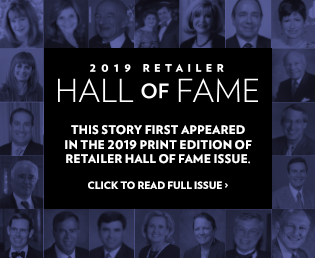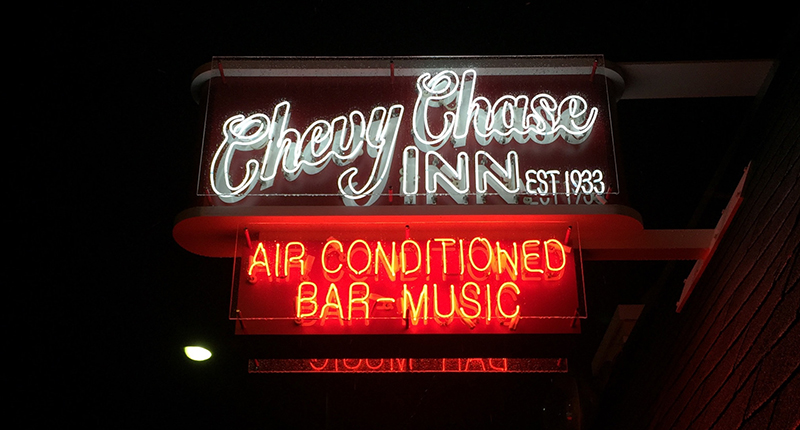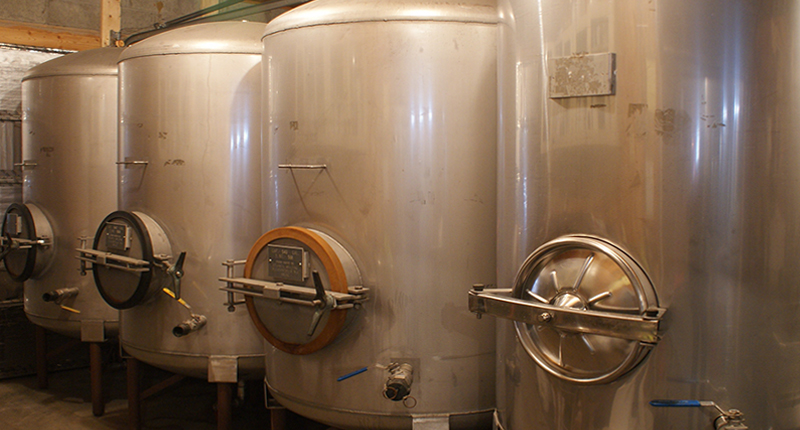Articles about crime, engagement rings, and a necklace worn in the World Series generated the most interest among readers.
Jewelers Uncork New Opportunities
A handful of retailers are lending their talents to the wine and spirits industry. We talked to them about their side businesses for a special feature in our Retailer Hall of Fame issue.


Over the years, the bar solidified its spot as the local watering hole, welcoming generation after generation into its low-key, homestyle atmosphere.
It was even immortalized in a 2013 book titled “Chevy Chase Inn: Tall Tales and Cold Ales From Lexington’s Oldest Bar,” which chronicled its history and shared tales from local patrons.
True to its Kentucky heritage, the inn serves up all types of bourbon, even hosting a “Pappy Thanksgiving” every fall to give customers a chance to try top-shelf Pappy Van Winkle bourbon at cost.
In 2015, Bill Farmer, owner of Farmer’s Jewelry, and two of his friends, bought the 85-year-old bar, saving it from turning into a run-of-the-mill retail space.
Like the Chevy Chase Inn, Farmer’s Jewelry has been stitched into Lexington’s neighborhood fabric since 1950, when his father opened the store on the same block of Euclid Avenue as the inn and a row of retail shops, including the city’s oldest flower shop.
“We approached buying Chevy Chase Inn as a chance to save something,” says Farmer, who felt the destruction of the bar would “ruin a lot of memories for a lot of people.”

The jeweler, who also serves as a Lexington-Fayette Urban County Council member, was already wearing many hats before deciding to move into the bar business.
“Retail drives you to drink,” says Farmer, with a hearty laugh.
In all seriousness, though, he notes that both his jewelry business and his bar business have something in common—they are there for people to celebrate and commemorate happy occasions.
Lessons learned as a jeweler carry over to his bar business, says Farmer, particularly the art of listening.
“If you can listen in retail, you can learn what the customer wants. Same in the bar.”
For jewelers looking to branch out into other areas, Farmer advises looking for an opportunity (like he had) within an existing local business or interest and being ready when that opportunity presents itself.
He warns against stretching oneself too thin or jumping too hastily into the unknown.
In the Heart of California Wine Country
For California jewelers Steve and Judy Padis, opportunity presented itself in 2004. They purchased property in the Oak Knoll region of California, which is located about an hour north of San Francisco in Napa County, and slowly began building out Padis Vineyards over 15 acres.
The couple owns and operates a handful of Padis Jewelry locations around the San Francisco Bay area but also are longtime wine collectors, amassing a stash of more than 10,000 bottles.
It was Judy who introduced her husband to the world of wine during the couple’s dates in Napa Valley.
“I had never really experienced wine tasting,” Steve admits. “It became a passion and as soon as we could afford it, we decided we were going to make our own wines.”
The Padises had their first vintage in 2008 with the help of master winemaker Robert Foley.
“If someone asks me what I do I say, ‘I do diamonds and wine.’” — Steve Padis, Padis Jewelry and Padis Vineyards
Currently, Padis Vineyards produces around 3,000 cases of wine per year, mostly red wine from their homegrown red grapes. About 10 percent of their production is chardonnay, which is made from grapes they’ve purchased.
Their inner jeweler shines through on their wine labels, with a cabernet dubbed “Brilliance” and a blend of cabernet sauvignon and syrah called “Sintilation.” (And, no, that is not a typo.)
“If someone asks me what I do I say, ‘I do diamonds and wine,’” Steve says.
The vineyard is situated between Napa’s warm upper valley and the cooler Los Carneros region to the south, just about an hour away from the couple’s San Francisco stores.
The seasonality of the wine business works in the Padises’ favor, slowing down as the jewelry business revs up in November and December.
The two worlds meet often, says Steve, with a lot of jewelry customers visiting the winery and vice versa. The couple has even held master classes at the winery, giving people a view of picturesque Napa Valley while they examine another natural beauty—the diamond.
European Winemaking in Western Pennsylvania
For jeweler Tom Glatz, the opportunity to branch out into the alcohol business came knocking at the back door.
The tasting room for Glatz Wine Cellars operates out of the rear of Glatz Jewelers in Aliquippa, Pennsylvania, a small town about 25 miles northwest of Pittsburgh.
Though the winery began in 2000, Glatz’s roots in winemaking go way back.
“People ask me how long I’ve been making wine. Longer than jewelry, I tell them,” he says, noting that his family has been making wine in Europe, mainly in Germany and France, for more than 200 years.

It’s still a family affair for Glatz, who operates the winery and jewelry store—which opened in 1976—with his wife Marlene, and his sons, Aaron (who makes the wine), and Dale (who repairs the jewelry).
The vineyard is just a few miles away from the store, spanning six acres on the family’s farm in neighboring Hopewell Township.
As with the Padises, the jeweler’s touch is apparent upon reading the wine list at Glatz, with bottles bearing names such as “Amethyst,” “Tanzanite,” “Topaz” and “Chocolate Diamond.”
The store and the winery flow seamlessly into each other. Customers often grab a glass to sample from the winery in the back, then step out onto the patio (located off the side of the store) to inspect potential jewelry purchases in the natural light.
The winery also doubles as an event space for local charities and fundraisers, which, in turn, helps to bring more attention to the jewelry business.
From Silicon to Napa Valley
While jewelers-turned-vintners have uncorked an additional revenue stream that pairs nicely with their stores, a small-production winery comes with its own challenges, says Carole Lawson, CEO of the Salem, Oregon-based Craft Wine Association.
Some of these challenges are unique to wine-making, while others will sound familiar to retailers, including: How do I entice people to buy what I’m selling?
There are tools and algorithms available to get a ballpark figure on what it costs to open a winery, but Lawson suggests adding 20 to 30 percent on top of that, accounting for weather and operating requirements that can vary by state.
“There’s a fantasy about what it’s like [to own a vineyard.] You don’t think about the pruning, the planting, the pests and the weather that can impact the production of the grapes themselves.” — Carole Lawson, Craft Wine Association
Glatz estimates he sank about $250,000 into producing his first bottle.
And, although the family has been making wine since 1980, it took the Glatzes years before they were able to sell their first bottle, due in part to Pennsylvania’s particularly strict alcohol laws.
After an arduous licensing process, including several attempts at getting their bottle labels approved, the Glatzes began marketing their wine in 2007.
Glatz once thought he would retire to his winery—a relaxing respite after years in the stressful world of retail—but has since thought better of it after learning first-hand what goes into the day-to-day operations of a vineyard.
“It’s a lot of work, about 14 hours a day,” says Glatz, who relies on his son and master winemaker Aaron and employees to do the manual labor.
“There’s a fantasy about what it’s like,” says the Craft Wine Association’s Lawson. “You don’t think about the pruning, the planting, the pests and the weather that can impact the production of the grapes themselves.”
The biggest challenge to operating a winery, she says, is being realistic.
One can buy a vineyard or buy grapes, press them, and bottle the wine with beautiful labels, but the real challenge is marketing it and getting people to buy it.
Still, Lawson, who spent decades working in Silicon Valley before “flunking out of retirement” and starting the Craft Wine Association, understands what draws people from other industries to wine.
“There is a romance about the wine industry,” she says, noting its similarity to jewelry in this way. “The marketers have done a great job of making it feel opulent and [giving it] a sense of having arrived.”
The Latest

As part of the leadership transition, Sherry Smith will take on the role of vice president of coaching strategy and development.

It marks the third time the country has headed the Kimberley Process. Ghana will serve as vice chair.

How Jewelers of America’s 20 Under 40 are leading to ensure a brighter future for the jewelry industry.

The new Bulova x Stetson designs highlight two animals often associated with the American West—the bison and the Texas Longhorn.


Its residency at Yamron Jewelers will run through May 2026.

The retailer is expanding into areas with large Indian and South Asian populations.

Roseco’s 704-page catalog showcases new lab-grown diamonds, findings, tools & more—available in print or interactive digital editions.

The Italian brand has opened its first flagship amid the peaks of the Dolomites in Madonna di Campiglio, Italy.

The new curation at the Natural History Museum of Los Angeles County showcases rare gem and mineral specimens in their uncut, natural state.

The couple pleaded guilty to concealing at least $127 million in cash transactions at its precious metals businesses.

Consumers shared concerns about prices, inflation, tariffs, trade, and politics in the survey’s write-in response section.

In February 2026, the auction house will move its headquarters to the former Steinway Hall, a neoclassical landmark on Billionaires’ Row.

The new show will take place Jan. 23-25, 2026.

The former BHP Billiton leader and Gemfields chairman is remembered for his influential leadership throughout his 50-year mining career.

The LVMH-owned brand has partnered with the costume design union to revamp its award for 2026.

The luxury titan inked a deal to acquire an initial minority stake in the jewelry manufacturer with a pathway to full ownership by 2032.

The company’s curation of unsigned vintage and estate jewelry debuted at the Bloomingdale’s in Costa Mesa, California.

In the recent multi-shipment seizure, CBP also found counterfeit Audemars Piguet, Moncler, and Chrome Hearts items.

Helzberg’s Chief Retail Officer Mitch Maggart shared details about its tests of a new store concept rooted in an elevated luxury experience.

Jewelers of America execs and National Jeweler editors discuss tariffs, the sky-high gold price, and the engagement that broke the internet.

The luxury goods company said founder Ippolita Rostagno will remain at the brand’s helm.

Laura Burdese, who joined the Italian luxury brand in 2022, will take on the role in July.

The National Jeweler editors revisit the most noteworthy industry happenings and design trends from 2025.

Need a gift for the cat lover who has everything? Look no further than our latest Piece of the Week.

It purchased the “Grosse Pièce,” an ultra-complicated Audemars Piguet pocket watch from the ‘20s, for a record-breaking price at Sotheby’s.

The lab-grown diamond grower now offers custom engagement and fashion jewelry through its Kira Custom Lab Jewelry service.



























